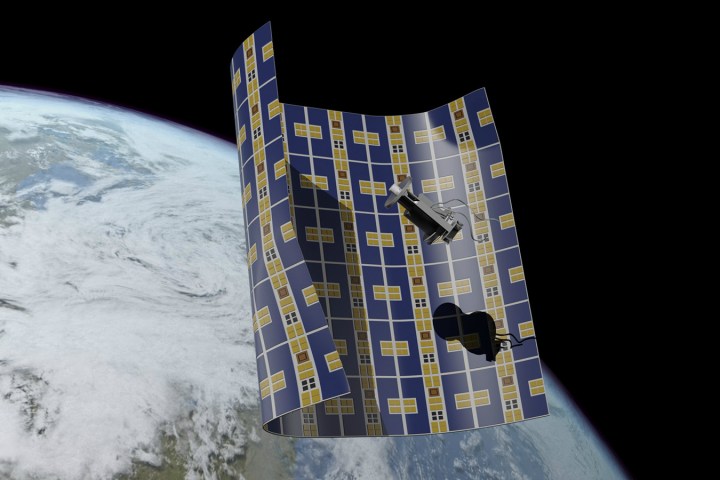
Orbiting at speeds up to 17,500 miles per hour, this vast collection of accumulated debris — some of which is as large as a school bus — has been the bane of space agencies and private companies for years. As we reported earlier this year, NASA has tinkered with an array of theoretical space janitors of sorts. What sets the Brane Craft apart though is its overall simplicity and affordability. The Aerospace concept conjured up by Siegfried Janson, is a flat (less than a human hair in thickness) 3-foot-square maneuverable spacecraft.
The units are constructed from a series of plastic sheets and each Brane Craft is printed with a thin layer of solar cells and electronics to power an onboard “electrospray thruster.” The propellant for this system is housed in tiny gaps (15-20 microns in length) between these flexible sheets. The Brane Crafts can transform their shape midflight using a series of “muscles.” This is done by sending an electric current between two metal plates on either side of an integrated polymer. This difference in voltage allows the polymer to bend. (If you’re imagining an expensive piece of flying cling wrap, you’re not too far off.)
“You can essentially think of it as one giant piece of Saran wrap covered with thrusters, and you can curl it however you want,” explained Jason Derleth, program executive of the NASA Innovative Advanced Concepts (NIAC) Program.
After a shipment of these crafts reach LEO, they can then be individually directed toward specific pieces of debris. Once deployed, the Brane Craft would then essentially envelop an item and then pull it towards the Earth’s atmosphere to be incinerated upon re-entry. Currently, space agencies would need to deploy conventional CubeSats to de-orbit debris. However, with a launch cost of $250,000 for a 3U CubeSat, NASA has estimated it would cost roughly $1 billion to remove 4,000 pieces of junk. Aerospace hopes to finalize a spacecraft that would cost only $5,000 to launch. Until these cosmic garbage-bots are deployed, we are simply biding our time before a seemingly inevitable large-scale debris impact event.
In 2015, astronauts aboard the International Space Station, were forced to seek emergency shelter after being notified of a potential collision with a piece of debris. This was the fourth time onboard astronauts had to prepare for such a scenario. The scientific community also fears that a major impact event could set off a domino effect of runaway, cascading collisions (similar to the event depicted in Gravity) that could render orbit impossible for decades.
“If that ever happens it will make space unusable essentially, and we’re pretty close to that,” Derleth warned.
Editors' Recommendations
- NASA is seeking help to crash the space station at the end of its life
- Space station astronauts take shelter as cloud of debris threatens their safety
- Researchers come up with method for cleaning up space debris using magnets
- Watch all the highlights of SpaceX’s latest spacecraft launch to ISS
- Space station’s Canadarm2 robotic arm survives debris strike


